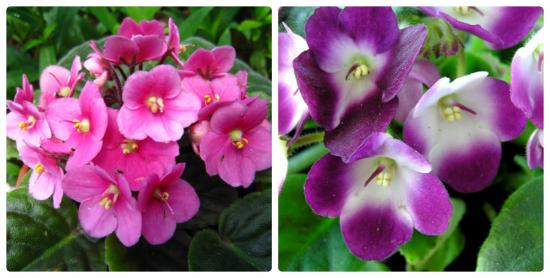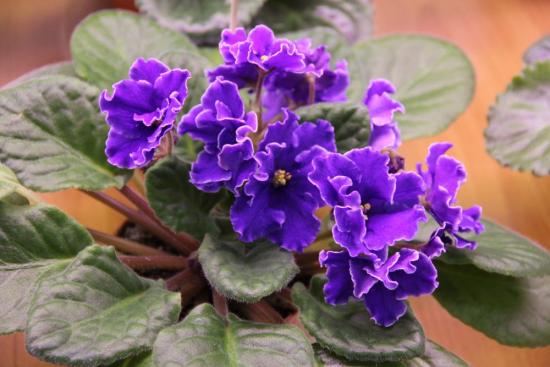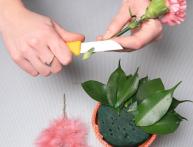How to plant a violet correctly and what are the secrets of caring for it?

Violet is a delicate and beautiful plant that is liked by many housewives. But once you buy one flower, you immediately want more. There are a large number of species and subspecies of violets, and to purchase them all you need to spend a significant amount. That is why flower lovers often prefer multiply her own violets, and shares them with fellow home flower lovers.
But, in order for the flower to grow healthy and constantly delight you with its appearance, you need to plant it correctly in a pot. How to do this without mistakes, how to prepare for planting, what soil to choose, and much more we will consider in our article.
Content:
Preparing to plant violets
To plant violets at home, you will need a good flower pot. It is best to plant violets in round, almost flat pots. They should not be deep, because the root system of the plant is close to the surface of the soil, and does not grow downward, but to the sides. The main rule when choosing a pot is that it should be 3 times smaller in diameter than the violet rosette.
Only in this case will you be able to enjoy succulent leaves and beautiful flowering. Plastic disposable cups or cut-off small bottles. They will be useful for rooting the plant.Purchase a ready-made soil mixture that will be used for landing.In many stores it is sold ready-made. The soil must be loose, light and well saturated with air.

But, some plant lovers want to control everything themselves, so you can prepare it yourself. In this case, you should prepare all the components. For this you will need turf soil, coniferous and leaf humus, peat, and fine river sand. Complex fertilizers that are useful for feeding the plant.
As soon as you prepare the soil, you must immediately add superphosphate to it as a fertilizer. After this, you need to feed the plant when buds form, and after flowering itself.
If planting occurs in winter, you also need to prepare a fluorescent lamp with which you will illuminate the young flower so that it does not feel a lack of light. To do this, fix the lamp at a distance of 20-25 cm from the plant and illuminate it for 10-12 hours. After going through such a simple preparation for landing plants, the procedure will be simple and easy.
How to prepare violets for planting
In addition to preparing the soil and the necessary conditions for planting, you need to carefully monitor the quality of the original material. A healthy flower cannot grow from a diseased shoot. For rooting, it is best to use leaves from the second row, because they have already reached the desired size and are saturated with useful substances in the required quantity.
Now inspect the sheet for mechanical damage, burns, dents, and other defects that may later lead to rotting.If you decide to plant a violet sprout that was rooted in a store, then the situation is even more complicated. In the winter months or mid-summer, the root system may be frozen or steamed.
But this will not affect the appearance of the plant in any way, so buying a flower in a store is always a risk. It's best to choose a flower in the spring, at this time the risk of buying a diseased flower is much lower. When choosing a plant, you need to pay attention to the following aspects:
- There should be no damage or cobwebs on the flower, which indicates the presence of insects.
- Look at the thickness of the leaf stem to see if they are elongated due to lack of light. Is the rosette of the flower symmetrically developed? What does the rosette of a flower look like, is there any rotting in it.
If everything is in order with the flower, then you need to carefully transport it home, give it a little time to get used to the new environment and temperature conditions, and then transplant the plant into a new pot.
How to plant a plant correctly?

Let's look at a few rules for planting rooted plants that are ready for independent life:
- Place a layer of expanded clay at the bottom of the pot. It will take over the function of drainage.
- Carefully remove the flower from the container in which it grew. Do not crush the earthen ball that was removed along with the roots, otherwise you risk damaging the root system.
- Carefully inspect the plant, remove the lower leaves, as well as dried, diseased or damaged ones.
- In the pot for landings pour the prepared substrate, making a small depression in the middle.
- Place the flower in the hole, sprinkle with soil, and press it slightly against the roots.Do not place the roots too deep, as they grow just below the top layer of soil.
It is very important that the lower leaves are slightly higher than the ground level. Otherwise, the plant will grow poorly and feel uncomfortable. If you decide to replant a flower due to poor growth, if the flower has withered or the soil has turned sour, then before performing the algorithm described above you will need to perform a few more manipulations:
- After removing the flower from the old pot, you need to carefully remove all the soil. She may be infected, or simply not suitable.
- Carefully examine the roots of the plant. You may notice roots that are rotting or have dried out. They need to be trimmed with scissors so as not to transfer the disease to a new pot.
- If you plant a violet in the same pot in which it grew before, then it should be thoroughly washed, dried, and doused with a solution of potassium permanganate.
This way, you will get rid of germs and bacteria that could remain on the walls of the dishes. The main rule when landing violets – find the optimal point for its deepening. It will be very difficult for a flower that is planted too deep to get used to new growth conditions and stabilize its position.
If the roots are planted too high, the plant will not look aesthetically pleasing or stable. If you do all the manipulations described above correctly and according to the instructions, then the violet will certainly thank you for your efforts with bright green and juicy flowers, and long-lasting flowering several times a year.
Video on how to plant violets:










